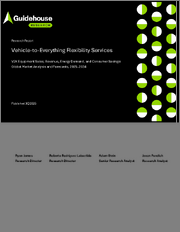
|
시장보고서
상품코드
1787829
세계의 V2X 유연성 서비스 시장(2025-2034년)Vehicle-to-Everything Flexibility Services - V2X Equipment Sales, Revenue, Energy Demand, and Consumer Savings: Global Market Analysis and Forecasts, 2025-2034 |
||||||
양방향 충전 기능을 갖춘 EV는 그리드의 유연성을 높이는 귀중한 자원으로 부상하고 있습니다. Vehicle-to-Everything(V2X)로 총칭되는 이러한 기술은 EV에서 가정, 건물, 그리드로 에너지를 전송하고 전력 수급의 균형을 맞추는 데 도움이 됩니다. EV의 보급이 진행됨에 따라 그리드 지원에 사용할 수 있는 누적 배터리용량은 피크 수요를 관리하고 시스템 탄력성을 높이는 중요한 자산이 될 것으로 예측됩니다.
이 보고서는 세계 V2X 유연성 서비스 및 양방향 충전기 시장에 대한 조사 분석을 통해 학교 버스 V2G, 상용차 V2B, 상용차 V2G, 주택 V2H, 주택 V2G의 5가지 주요 이용 사례에서 장비 판매, 수익, 에너지 수요에 미치는 영향 및 소비자 비용 절감에 대한 상세한 예측을 제공합니다.
목차
제1장 주요 요약
- 소개
- 범위
- 시장 전망
제2장 시장 문제
- 소개
- V2X 개요
- V2X의 구현
- 양방향 충전기와 시스템 설계
- 그리드의 유연성을 지원하는 차량의 역할
- 이용 사례
- 스쿨 버스
- 상용 플릿
- 주택
- V2X에 적합하지 않은 이용 사례
- 시장 성장 촉진요인
- V2X 대응 EV와 양방향 충전기 증가
- 에너지 비용 절감과 수익 전망
- 탄력
- 장벽
- 이해관계자 우선순위 갈등
- 상호 운용성과 표준화
- V2X의 비용
- 낮은 소비자 참여율
제3장 산업 밸류체인
- 경쟁 구도
- M&A 활동
- 가격 설정
- 비즈니스 모델의 진화
제4장 시장 예측
- 조사 방법
- 세계 예측
- 양방향 충전기의 매출과 전개
- 양방향 충전기 판매
- V2X 용도의 에너지 수요에 대한 영향
- 고객의 비용 절감과 수익
제5장 결론과 제안
- 3개의 큰 포인트
- 권고
- 자동차 OEM
- EVSE 제조업체
- V2X 소프트웨어 제공업체
- 유틸리티
제6장 두자어 및 약어 목록
제7장 목차
제8장 도표
제9장 조사 범위, 정보원, 조사 방법, 주석
JHS 25.08.14EVs equipped with bidirectional charging capabilities are emerging as a valuable resource for grid flexibility. Known collectively as vehicle-to-everything (V2X), these technologies allow EVs to transfer energy to homes, buildings, and the grid, helping to balance electricity supply and demand. As the number of EVs on the road increases, the cumulative battery capacity available for grid support is expected to become a significant asset for managing peak demand and enhancing system resilience.
This report analyzes the global market for V2X flexibility services and bidirectional charging equipment from 2025 to 2034. It provides detailed forecasts for equipment sales, revenue, energy demand impact, and consumer cost savings across five key use cases: school bus vehicle-to-grid (V2G), commercial fleet vehicle-to-building (V2B), commercial fleet V2G, residential vehicle-to-home (V2H), and residential V2G. Charging equipment revenue is segmented into hardware, installation, power management systems, operations, and maintenance. The report also examines regional trends in North America, Europe, and OECD Asia-Pacific, highlighting the policy, technology, and market factors shaping adoption.
Guidehouse Research expects the market for bidirectional charging equipment to grow substantially over the next decade as V2X technologies move from pilot projects to broader deployment. Residential use cases are projected to account for the largest share of installations, reflecting the high number of individually owned EVs with V2X capabilities. The report offers guidance for stakeholders-including vehicle OEMs, EV supply equipment (EVSE) manufacturers, software providers, utilities, and grid operators-on how bidirectional charging systems may evolve to support grid flexibility and enable new energy management strategies.
Table of Contents
1. Executive Summary
- 1.1 Introduction
- 1.2 Scope
- 1.3 Market Outlook
2. Market Issues
- 2.1 Introduction
- 2.2 Overview of V2X
- 2.2.1 V2X Implementation
- 2.2.2 Bidirectional Charging Equipment and System Design
- 2.3 Role of Vehicles in Supporting Grid Flexibility
- 2.4 Use Cases
- 2.4.1 School Buses
- 2.4.2 Commercial Fleets
- 2.4.3 Residential
- 2.4.4 Use Cases Not Suited for V2X
- 2.5 Market Drivers
- 2.5.1 Growth of V2X-Capable EVs and Bidirectional Chargers
- 2.5.2 Energy Cost Savings and Revenue Potential
- 2.5.3 Resilience
- 2.6 Barriers
- 2.6.1 Conflicting Stakeholder Priorities
- 2.6.2 Interoperability and Standardization
- 2.6.3 V2X Costs
- 2.6.4 Low Consumer Participation
3. Industry Value Chain
- 3.1 Competitive Landscape
- 3.1.1 M&A Activities
- 3.1.2 Pricing
- 3.1.3 Business Model Evolution
4. Market Forecasts
- 4.1 Methodology
- 4.1.1 Key Assumptions
- 4.1.2 Modeling Limitations
- 4.2 Global Forecasts
- 4.2.1 Bidirectional Charger Sales and Deployment
- 4.2.2 Bidirectional Charging Equipment Revenue
- 4.2.2.1 Hardware Revenue
- 4.2.2.2 Installation Revenue
- 4.2.2.3 Power Management System Revenue
- 4.2.2.4 Operations and Maintenance Revenue
- 4.2.3 Energy Demand Impact of V2X Applications
- 4.2.4 Customer Cost Savings and Revenue
5. Conclusions and Recommendations
- 5.1 Three Big Takeaways
- 5.2 Recommendations
- 5.2.1 Vehicle OEMs
- 5.2.2 EVSE Manufacturers
- 5.2.3 V2X Software Providers
- 5.2.4 Utilities









